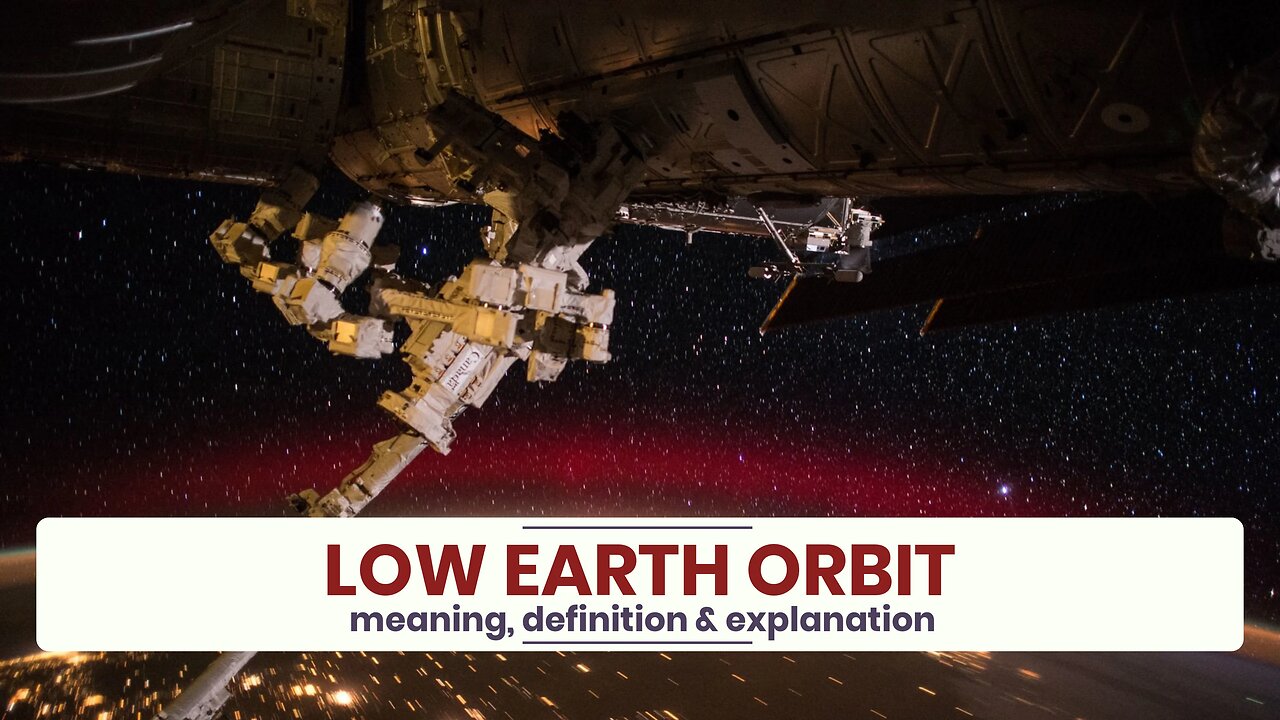Premium Only Content

What is LOW EARTH ORBIT?
✪✪✪✪✪
http://www.theaudiopedia.com
✪✪✪✪✪
What does LOW EARTH ORBIT mean? LOW EARTH ORBIT meaning - LOW EARTH ORBIT definition - LOW EARTH ORBIT explanation. What is the meaning of LOW EARTH ORBIT? What is the definition of LOW EARTH ORBIT? What does LOW EARTH ORBIT stand for? What is LOW EARTH ORBIT meaning? What is LOW EARTH ORBIT definition?
A low Earth orbit (LEO) is an orbit around Earth with an altitude between 160 kilometers (99 mi) (orbital period of about 88 minutes), and 2,000 kilometers (1,200 mi) (about 127 minutes). Objects below approximately 160 kilometers (99 mi) will experience very rapid orbital decay and altitude loss. The orbital velocity needed to maintain a stable low Earth orbit is about 7.8 km/s, but reduces with increased orbital altitude.
With the exception of the manned lunar flights of the Apollo program, all human spaceflights have taken place in LEO (or were suborbital). The International Space Station conducts operations in LEO. The altitude record for a human spaceflight in LEO was Gemini 11 with an apogee of 1,374.1 kilometers (853.8 mi). All manned space stations to date, as well as the majority of satellites, have been in LEO.
Objects in LEO encounter atmospheric drag from gases in the thermosphere (approximately 80–500 km up) or exosphere (approximately 500 km and up), depending on orbit height. Due to atmospheric drag, satellites do not usually orbit below 300 km. Objects in LEO orbit Earth between the denser part of the atmosphere and below the inner Van Allen radiation belt.
The orbital velocity needed to maintain a stable low Earth orbit is about 7.8 km/s, but reduces with increased orbital altitude. Calculated for circular orbit of 200 km it is 7.79 km/s and for 1500 km it is 7.12 km/s. The delta-v needed to achieve low Earth orbit starts around 9.4 km/s. Atmospheric and gravity drag associated with launch typically adds 1.3–1.8 km/s to the launch vehicle delta-v required to reach normal LEO orbital velocity of around 7.8 km/s (28,080 km/h).
Equatorial low Earth orbits (ELEO) are a subset of LEO. These orbits, with low inclination to the Equator, allow rapid revisit times and have the lowest delta-v requirement (i.e., fuel spend) of any orbit. Orbits with a high inclination angle to the equator are usually called polar orbits.
Higher orbits include medium Earth orbit (MEO), sometimes called intermediate circular orbit (ICO), and further above, geostationary orbit (GEO). Orbits higher than low orbit can lead to early failure of electronic components due to intense radiation and charge accumulation.
Although the Earth's pull due to gravity in LEO is not much less than on the surface of the Earth, people and objects in orbit experience weightlessness because they are in free fall.
A low Earth orbit is simplest and cheapest for satellite placement. It provides high bandwidth and low communication time lag (latency), but satellites in LEO will not be visible from any given point on the Earth at all times.
-
 2:28
2:28
The Audiopedia
1 year agoWhat is MORTGAGE BROKER?
22 -
 41:26
41:26
The Mel K Show
5 hours agoMel K & Clay Clark | Financial Success Hides Behind Self Discipline: Five Pillars | 8-24-25
31.9K3 -
 LIVE
LIVE
The Rabble Wrangler
13 hours agoThe Best in the West Plays Battlefield 2042 | Road to BF6 Grind
31 watching -
 2:29:17
2:29:17
JTtheSG
2 hours agoLIVE Replay - Back To The Deadzone!!!
13.8K -
 LIVE
LIVE
The Official Steve Harvey
13 days ago $5.14 earned24 HOURS OF MOTIVATION w/ STEVE HARVEY
252 watching -
 25:56
25:56
DeVory Darkins
23 hours ago $0.86 earnedTrump drops ULTIMATE BOMB on Democrat Mayors as ICE makes SHOCKING Announcement
52K184 -
 3:36:30
3:36:30
TonYGaMinG
8 hours ago🟢 ABI WITH FRIENDS | 🍩JOE DONUTS | 😶 🌫 VLADSGAMINGCARTEL |
28.1K4 -
 21:24
21:24
marcushouse
14 hours ago $0.12 earnedStarship Flight 10: Go or No? 🚀
36.7K13 -
 6:25:15
6:25:15
MrR4ger
19 hours agoSUNDAY FUNDAY w/ R4GER - VARIETY ANOTHER FCKN STREAM CRASH
29.5K -
 5:40
5:40
WhaddoYouMeme
4 days ago $0.33 earnedThey’re Calling This the End of Masculinity
41.6K37